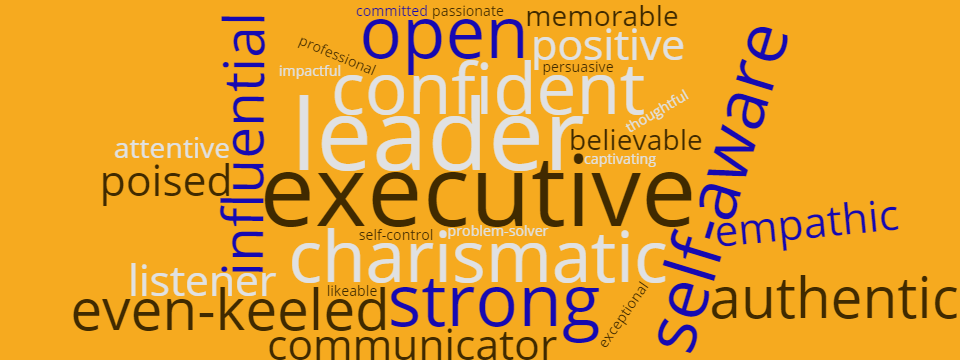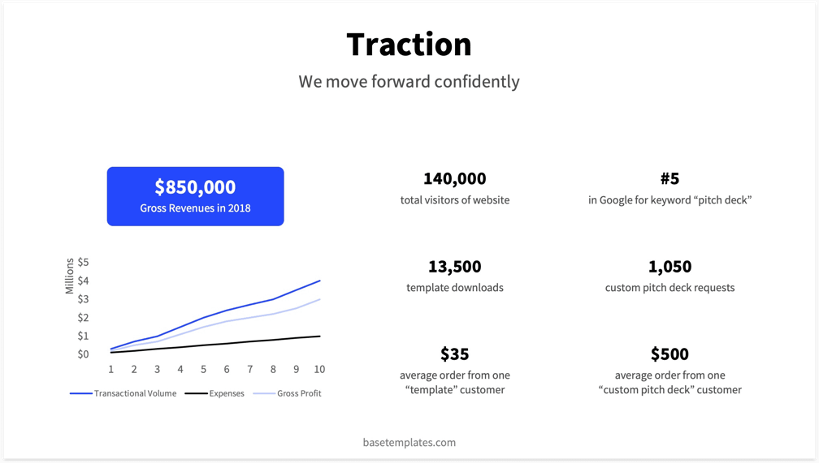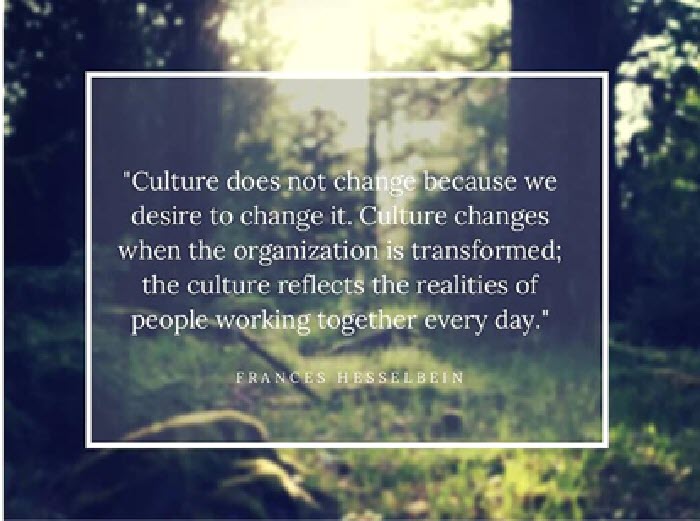
This is a Guest blog post by William E. Dyess, “Pitchmaster General” and Principal at TXN Advisors, a Washington, DC-region business consulting firm that provides corporate development, marketing and strategic advisory services.
This post is an analysis of the last 50 pitch decks we received at The Dyess Group’s deck review portal and our strategy on building a winning deck.
The Basics of Deck Building
At The Dyess Group (TDG) we generally follow the Sequoia Pitch Template when building decks for clients, but with our own spin. Whether you use the Sequoia template or not, it is important to follow a thoughtful narrative flow that induces and compels the reader to take the desired action. There are several effective, proven models and suggestions such as the Dale Carnegie Transactional Selling Steps from the 1950s:
- Attention (What is the sizzle?)
- Interest (Why does it matter? Why does the world need you? )
- Desire (Are you better than a traditional solutions to the same problem?)
- Conviction (How do you handle objections, what’s the traction?)
- Action (Ask for the order, go for the close!)
The important practice here is to design a narrative flow that you believe fits your company the best and make it yours. Below we will present what we have found are the elements often forgotten, missed, or misunderstood when building an effective narrative flow. We do this using the first three slides of the Sequoia model.
Tip #1: Make sure people understand what you do, as quickly as possible (Don’t Waste Your Title Slide!)
We usually don’t hear about what the product or service does until the 5th slide.
The single most important thing you can do in your deck is to make sure people understand what you do. It needs to be in layman’s terms — meaning without using a lot of “marketing speak” and it needs to happen immediately.
When an investor, or any audience, clearly understands what you do, it provides much needed context to the rest of your story. The following is a front slide example from a deck The Dyess Group created for its client company Guac.
An example front slide from a Dyess Group deck
Here is another example illustrating how a very small amount of information immediately helps the reader (e.g., investor, partner, customer) orient themselves properly for the rest of the deck. This is for our customer, Socrates.
Tip #2: Find ways to combine key information into your narrative to make your deck more concise
Roughly 20% of the decks we review have the “Market Size” slide as the one of the first 3 slides.
And it almost always says one thing…the market is big. Unfortunately, putting this information so early is often disruptive to an effective narrative flow. Although Market Size is important and relevant, it is tangential information that can be a distraction at odds with understanding the opportunity. An alternative technique for getting attention with the size of the market is to combine the information with more important aspects of the narrative flow.
Tip #3: Combine traction and the solution to drive conviction to invest early
Only 15% of the decks we review feature customer referrals or actual market traction in the first three slides.
A solution without traction is really just an idea. You haven’t proven that you’ve solved anything. You want to eliminate as much risk from your offering as early as possible by enhancing the reader’s conviction. Introducing your product without any supporting traction in the same slide, or soon thereafter, doesn’t help the reader understand how far you’ve come in solving your problem. Inline with embedding statistics into the narrative, consider including some of the following along with your product:
- Customer Testimonials
- Success Rates
- Total Users
- Growth Rates
Applying lessons from User Experience (UX) research techniques to your pitch deck
UX research is the unsung hero of your favorite apps. A world leader in research-based UX consulting, Nielsen Norman Group have researched and documented the effectiveness of many UX techniques. We apply their forward-thinking UX methodologies to pitch decks we build for our clients.
UX Techniques
VCs only spend about three minutes reading your deck before a meeting. People can only keep seven things (plus or minus two) in their working memory. You have limited time and space to make your point, so raise the bar with respect to what information makes the cut. Key things to keep in mind through the body of your deck:
- Reduce the hard work for consuming key information (Rate of Gain)
- Don’t over-burden the reader with information (Cognitive Load)
- Be as succinct with your messaging as possible (“BLUF”)
- Organize information for max understanding (Progressive Disclosure)
- Give the deck some design basics for strong ethos (Halo Effect)
Each of these is discussed in greater detail below.
Rate of Gain
The Rate of Gain is the value a reader gets from new information divided by how much work that user needs to do to get it.
A measurement used in User Experience to measure ease of use and value to users
In the case of your pitch deck, the user is an investor, partner, or customer, and Rate of Gain measures how valuable the information on each page is divided by how many words are on the page.
This would mean that a good slide would have the most valuable information possible in the least amount of words.
How to have a high Rate of Gain in your content
One of our partners hired a highly coveted speech writer for a Series B raise and the main piece of advice — delete more words.
The best piece of free advice we can give you about your deck is to delete more words.
Cognitive Load
It’s well documented that there are limitations of one’s ability to remember things while doing a task, aka working memory. People have a very finite working memory to consume the content of your pitch. This is why you should use techniques to be as succinct as possible to convey the most value.
A reader may naturally try and determine what information they need to know in order to preserve their working memory. This means giving the reader the ability to triage a page to decide whether or not they need all of the information is a good technique for keeping a user’s memory free to remember the main points.
This really forces you to boil down the words on a page to the point where you keep track of the cost and benefit of each word. Each additional word adds additional cost to the reader to try and understand.
Bottom Line Up Front (“BLUF”)
There is a concept in journalism called the Bottom Line Up Front, you can also think of this as TL;DR (Too Long; Didn’t Read). It’s the same reason that we put an abstract at the beginning of a research paper, or an executive summary at the beginning of a business plan. Respect the reader’s time and tell them the main point up-front so they can triage the page and decide if they need to look at the details or not.
If you use a “headline” based approach you will allow readers to skim the page and decide if it’s something that they think they need to invest the effort to further investigate. If the reader avoids taking in more information than they need, they can arrive at the end of the deck quickly having only read the information they cared about. This will reduce frustration and increase retention and overall satisfaction.
Progressive Disclosure
The concept of progressive disclosure in apps defers advanced or rarely used features to a secondary screen, making the learning process easier and less error-prone. For applications, this means showing the most important features front-and-center and leaving the seldom used, or less important features to be shown later or at the users request. This removes added complexity of needing to understand more features than may be necessary.
Take Google for example. The home page is literally just a search box, and the ability to search (or click I’m Feeling Lucky like I always do).
Now you’ve given the user the option, should they want more information, to go find it. In deck-writing, progressive disclosure serves two ends: keeping the deck clean and succinct, but also allowing the user ready access to any information they would need — perhaps even in an appendix.
Halo Effect
The halo effect is a phenomenon that causes people to be biased in their judgments by transferring their feelings about one attribute of something to other, unrelated, attributes. In the case of decks, the overall aesthetic and cleanliness of the deck will set the sense of sophistication to your reader. The easiest way to create this is to be concise; use abundant white space and be consistent throughout.
- Consistent margins (white space is your friend)
- Consistent use of font sizes (we use 32pt and 18pt fonts for everything)
- Consistent messaging (Whatever you call it, call it that every time)
We’ll cover this topic in more depth later in the series.
Pulling It All Together
The slide design below does a good job implementing the UX techniques we just covered.
- Rate of Gain: With only two to three lines (tops!) for the main message, the value of the information is high, and the workload to obtain it is low.
- Cognitive Load: By using the headline approach, we allow readers to triage whether supporting information below the headline is worth further investigation.
- Progressive Design: Byincluding the path to more information, you let users know that there is a way to learn more. In doing this you also free their minds to focus on the slide at hand.
Fundraising is always hard. Fundraising in the current climate is harder. There has never been a better time to make sure your company can stand out, effectively deliver its message, and spark the interest of investors who will be more selective than ever before. Use the Sequoia Pitch Template and our techniques outlined here to make it easy for them to understand what you do and why your company deserves to be at the top of the stack.
William E. Dyess is “Pitchmaster General” and Principal at TXN Advisors, a Washington, DC-region business consulting firm that provides corporate development, marketing and strategic advisory services. We work in partnership with executive management to save them time and advance the corporate mission by helping them create killer pitch decks, management and investor presentations, board reports, corporate dashboards and the underlying business strategy and messaging to maximize growth and value. William can be reached at wdyess@thedyessgroup.com
Email your deck to deck@thedyessgroup.com for a free deck review.




:max_bytes(150000):strip_icc():format(webp)/charlie-munger_final-f94bc90f6af74c21a3f29d90ef20b487.jpg)
























